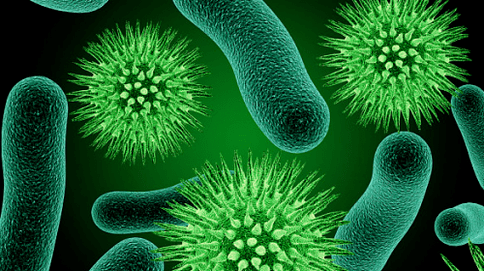One type of worm that parasites the human body is the worm, or in other words the helminths. These parasites have an amazing ability to live and multiply extremely quickly in a wide variety of internal organs: liver and kidneys, brain and muscle tissue, eyes, and intestines.

To our great regret, many people simply underestimate the danger and severity of these parasites, while the diseases caused by worms are found in different parts of the planet. Therefore, a topic like worms: the symptoms of adult patients are extremely important to everyone.
Worms: causes and types
Many people think that in order not to get infected with worms, it is enough to wash your hands more often and follow the general rules of hygiene. But this is not the case. Almost 70% of the world's population carries worms.
It is quite difficult to detect the presence of worms in an adult’s body if you are not a doctor who specializes in this area of medicine. This is due to the fact that the disease has virtually no obvious symptoms or signs.
There are several common signs that parasites have appeared in the body:
- One gets tired quickly, often showing aggression and anger for no apparent reason. Patients are often severely depressed. Such people do not sleep well or suffer from insomnia.
- The patient's abdomen often has pain and discomfort, throbbing, bloating, and bloating. Patients lose their appetite and lose weight quickly. Or perhaps the other way around: patients have an overly strong appetite and are unable to get enough food. Constipation or diarrhea are common.
- Due to the fact that helminths feed on the blood of their "owner", the patient often shows symptoms such as anemia or anemia.
- Carriers of the worm often suffer from any rash of the skin or mucous membranes and also exhibit a variety of allergic reactions.
If a person notices at least one of these signs, they should warn them and contact a medical facility immediately.
The main way in which helminths get into the body is through the gastrointestinal tract, along with food or drink. Parasitologists identify the following main ways of infecting parasites:
- Helminthiasis. Parasites enter the patient's body through drink or soil. This could be direct contact with the animals or swallowing the eggs of flies laid on food or fruit and vegetables.
- Contact. This mode of infection with parasites is likely to occur through contact with an already infected individual.
- Biohelminthiasis. In this case, the parasites enter the body due to the consumption of poorly cooked meat from animals, poultry or fish.
- Insect bites. Mosquitoes are one of the most common carriers of worms. While biting a sick and healthy person, the mosquito infects the second with worms.
It follows from the above that there are several ways to infect worms. But one of the most common and dangerous methods is stool-oral (with food and water).
The human body is a rather complex mechanism with certain limitations that prevent helminths from entering and developing in the body.
One of the first barriers is saliva, which contains many different enzymes. These enzymes are uniquely capable of adversely affecting the vast majority of worms.
If the worms did survive, they penetrate the stomach. But even here, a rather unpleasant surprise awaits them - hydrochloric acid and various enzymes that have all the necessary properties to kill many parasitic species. In addition, the natural intestinal immunity of humans should not be underestimated.

Intestinal microflora, enzymes, blood cells - these are the tireless fighters against worms. These natural barriers are designed to protect our bodies from parasites. But as this armor weakens, various types of worms begin to actively attack our bodies.
In order to know exactly how to treat parasites, you need to know their species and characteristics. The classification of worms can be divided into three major groups:
- Roundworms. Representatives of this group are also called nematodes and have more than 24, 000 species of parasites. The distinguishing feature of Roundworms is their shape, which has a round cross-section. They have a long and elongated body, both ends pointed. The most common species of this type of parasite are the tapeworm, the whipworm, the needle worm, and the trichinae.
- Tapeworms. One of the most defining characteristics of the life cycle of these types of parasites is that they have an intermediate "host" that is an animal or fish. Consumption of poorly cooked or raw animal or fish meat has an almost 100% chance of infecting tapeworms. The most common members of this species are the tapeworm, the bovine tapeworm, the dwarf tapeworm, and so on.
- Balekok. The members of this group have a flat, leaf-shaped body, up to 1. 5 to 2 m long. At one end of the base are two suction cups that allow the parasites to attach to the substrate. Metastasis usually affects the intestines, muscle tissue, or the human nervous system.
Diagnosis of worms in humans
It is quite difficult to determine the presence of worms in an adult’s body. This is due to the fact that the symptoms of helminthiasis (headache, poor appetite, fever, gastrointestinal disorders, etc. ) are quite similar to those of other diseases.
In addition, the symptoms of the presence of helminths in the patient's body are often a banal allergy. There are often cases where the parasitologist is likely to suspect that the patient is worm, this is not confirmed by laboratory tests, and the patient has been unsuccessful for a long time due to dysbiosis.
Worms: symptoms in adults, treatment - this issue has occupied our society for more than a hundred years. One of the most common and commonly used methods for the detection of helminthiasis in adults is the analysis of feces for the detection of worm eggs.
Unfortunately, the efficiency of this method is only 20%. And the remaining 80% of patients cannot be diagnosed with the presence of helminths in the body. The low effectiveness of such an analysis lies in the fact that professionals do not take into account a fact such as the laying period of the worms. Take roundworms as an example. They lay eggs mainly in the morning (4-5 p. m. ). This means that the stool taken for evening analysis does not show the presence of wormwood.
Parasitologists often use a method like enterobiasis. The essence of this technique is to scrape the patient into the anal canal. Unfortunately, this method is also not very effective.
Blood testing of the patient also does not give a high rate for detecting the presence of helminths. In both cases, the reason is the same - the time of analysis and the period of cyst selection do not coincide.
Some experts use a specially designed test that answers about 50% of a patient's development of helminthiasis. Here are the test questions:
- Do you feel itchy in your anus?
- Whether there is a rash on the skin.
- You have nausea in the morning.
- She suffers from sleep disorders.
- Is there bitterness in your mouth?
- Are your lymph nodes swollen?
- Do you notice pain in the muscle area?
If the patient gives a positive answer to 7 questions, this may indicate the presence of helminths in an adult’s body.
Modern medicine recommends the use of a method such as testing with an ultraviolet skin scanner. Unfortunately, this method of diagnosing helminthiasis is not often used. This is due to the fact that the equipment needed to perform it (ultraviolet skin scanner) is quite expensive and not all healthcare institutions can afford to buy it.
Not only cysts of worms but also parts of the body can be determined in the stool using a method similar to histological coprograms. The essence of this method is to examine several layers of feces under an electron microscope. This method allows parasitologists to achieve the most accurate results.
To determine the presence of worms in a patient's lungs, doctors prescribe an X-ray and a laboratory examination of the patient's sputum.
With the help of computed tomography or ultrasound, parasitologists can easily determine the presence of parasites in a patient’s organs such as the liver or brain.
A complete blood count or immunoassay will help identify the presence of parasites in the patient's blood. Several methods are used by those skilled in the art to determine whether a patient has helminthiasis.
Unfortunately, none of them can give the most reliable results. In this regard, there are cases where the treatment process does not give positive results but only aggravates the clinical picture and the general condition of the patient.
The most effective drugs for the treatment of different types of worms
Worms in adults, symptoms and treatment - these two concepts are closely related and directly related.
The process of treating helminthiasis is a rather difficult task. For example, some diseases caused by intestinal worms are similar to cancer, such as alveococosis. Other diseases caused by tapeworms or echinococcus can only be treated with surgery.
The third type of disease cannot be treated with tablets. The method of treatment chosen depends on how correctly the type of parasites established in the adult body has been determined.
The complexity of the treatment lies in the fact that anthelmintics only kill adults, and larvae and eggs remain in the human body and continue to parasitize there.
All medicines used to kill worms can be divided into the following groups:
- Devices containing mebendazole. This class of drugs is most commonly used to treat diseases such as ascariasis, teniasis, echinococcosis, alveococcosis, capillary coccosis, mixed helminthiasis, and the like.
- Preparations containing diethylcarbamazine. Basically, these foundations have shown excellent results in the treatment of diseases affecting the human lymphatic system, subcutaneous fibers and eye tissues.
- Devices that contain the active substance Levamisole. Such devices are generally free from cotorosis, enterobiasis, trichostrogillosis, trichocephalosis, and the like. used to treat.
- Preparations containing albendazole. It is mainly used to treat cysticercosis and ascariasis.
Under no circumstances should it be forgotten that self-medication is not recommended when helminthiasis is detected. This can lead to complications and worsening of the clinical picture of the disease.
The main reason for this is that most anthelmintic drugs have toxic properties and require a specially designed dosing regimen.
In order to achieve a positive treatment, a healthcare professional specializing in parasitology should be contacted. In addition, strict adherence to physicians' recommendations is a prerequisite for treatment.
Parasites in the human body, like worms, are extremely dangerous to human health. In order for the treatment process to be most effective, parasitologists make every effort to determine as accurately as possible which species of parasites are present in the patient's body.
Doctors use a fairly large list of drugs to kill the worms. But self-healing is by no means recommended. A separate treatment regimen, dosage, and course duration will be developed for the treatment of helminthiasis. It is recommended that the instructions of parasitologists be strictly followed.



























